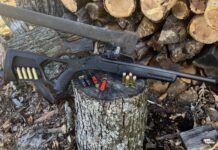Much of the fame of today’s sporting BAR began through the fame of the original military BAR designed by John M. Browning near the end of World War I.
This rifle, called the BAR M1918, was commissioned by the U.S. Army in an effort to break the stalemate of trench warfare in the battlefields of France and Belgium. It took John M. Browning three months to design it. Browning took this project so seriously that his son Val personally did testing and training of the American troops. In its short time at the front the sound of a BAR became legendary. At 330 rounds per minute every shot was distinguishable and the sound became uniquely associated with the BAR, a sound that struck fear into the hearts of the enemy.
The BAR made a strong comeback in World War II as the 1918A2. The newer version had a higher rate of fire (550 rounds per minute) and soon became an integral part of many American units on every front.
Here are a few interesting BAR facts you may never have heard before.

The Browning BAR sporting version is certainly a distinct and separate rifle from the military BAR M1918, but its design is the result of Browning’s unmatched understanding and expertise with automatic rifles that started with John M. Browning. His grandson, Bruce Browning, was the driving force behind today’s BAR. A large team of automatic firearms experts at the FN factory in Belgium also played a key role in its development.
This group of FN automatic rifle designers, lead by Marcel Olinger, began serious work on the project code named “Carbine 66,” with full scale development and testing done throughout 1966 in preparation for an official 1967 product launch.
The original prototypes had the distinctive scalloped receiver, which all early BARs had. The trigger group assembly was reliable, but complex. The design required the disassembly of the buttstock from the receiver to remove the trigger group. BARs at that time came with your choice of a right or left handed safety, but they were not reversible. All calibers were built on a long action length receiver.
The BAR rifle was initially produced totally in Belgium and then assembly was transferred to Portugal in the early 1970s. This was history making for Browning, as the BAR was the first Browning firearm made in Belgium with assembly at an all new Browning plant in Viana, Portugal.
Today, the Portugal factory has grown to be a major component of the Browning manufacturing system and is where the BAR continues to be assembled today, as well as the 12 and 20 gauge Gold and Silver autoloading shotguns and limited runs of the Hi-Power pistol. Contrary to what some have said, the BAR has always been made in Belgium and assembled in Portugal from the beginning.
The BAR has evolved slightly for over four decades. Rifles before 1976 are usually called Type 1 rifles. Between 1976 and 1992 they are often called Type 2 rifles, but these rifles are very similar to the original models. 1993 marked the introduction of the Mark II versions, which are still in production today.
Not well known to many was a special project in the early 1970s to produce a BAR version just for law enforcement. This rifle featured a slightly modified, high capacity FN FAL magazine and was chambered in 308 Winchester. However, the rifle never made it into production.
The product development team on the Mark II included a young engineer named Joseph Rousseau. It was on a trip to Browning’s Morgan, Utah offices in 1988 that Rousseau fell in love with the Utah mountains and Utah hunting. Rousseau eventually moved his family to Utah and today he is the Vice President of Research and Development at Browning’s Morgan, Utah headquarters.
The Mark II included several significant modern upgrades. A trigger assembly retained by cross pins was included for easy disassembly. At the same time the gas system was redesigned for greater reliability. A slide stop was added as a separate lever allowing you to keep the bolt in the open position with or without the magazine inserted.
At this time the BAR received major improvements in both reliability and accuracy. According to Rousseau, the Mark II was originally qualified with a fully detachable magazine, but the change was never put into production. The BAR Mark II kept its original hinged type magazine found on the originals.
Few people recall the pump action version of the BAR introduced in 1997 and called the BPR. It was offered in seven calibers in both long and short action versions, including magnums. It provided many of the distinctive advantages of the BAR Mark II, but in a version that could be used in states that were not enthusiastic about civilian ownership of autoloading centerfires.
At the time Browning management was worried that this could become a trend, but luckily this did not happen. In 1999 another variation, the Acera, made its U.S. debut. Originally developed for the European market, this straight-pull bolt-action design based on the BAR hit the U.S. market with minimal fanfare. The BPR and Acera are among the rarest of BAR variations and highly sought-after by Browning collectors.
Today’s BARs come in the new ShortTrac and LongTrac variations. Built with lightweight aluminum receivers and modern styling, they offer all the advantages of the originals. Both the Lightweight and the Safari – based on the Mark II configuration – are still in the line as well.



























